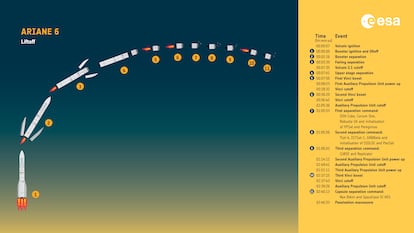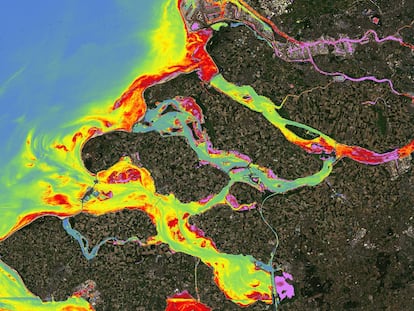Europe launches the Ariane 6, the most powerful rocket in its history
The European Space Agency is attempting the first flight of the largest device developed on the continent
Everything is ready for the takeoff of the Ariane 6, the largest and most powerful rocket developed by Europe. The European Space Agency (ESA), made up of 22 countries, trusts that this new device will allow it to access space independently to launch institutional and private robotic missions, without needing to depend on companies like SpaceX, led by tycoon Elon Musk. The rocket, as tall as an 18-story building and weighing more than 500 tons, is scheduled to take off at 3:00 p.m. Eastern Daylight Time, one hour after the initial plan.
“Standing next to the massive Ariane 6 is indescribable,” ESA Director General Josef Aschbacher posted Tuesday on the social network X, from the European Spaceport, in French Guiana. “I feel a wide-range of emotions as we get ready to make an impact on European history, for Europe’s future, for generations of Europeans.”
Ariane 6 will power Europe into space. Ariane 6 will make history.
— Josef Aschbacher (@AschbacherJosef) July 9, 2024
Standing next to the massive #Ariane6 is indescribable. I feel a wide-range of emotions as we get ready to make an impact on European history, for Europe's future, for generations of Europeans. This is just the… pic.twitter.com/4B9uB84X55
Three French Air Force fighters have been deployed in the vicinity of the spaceport as part of Operation Titan, the military operation to ensure that the airspace is clear for Ariane 6 to take off. Ships and anti-aircraft weapons from the French Army are also involved in the operation. It’s a level of security that is not common in other launches, and highlights the geostrategic importance of Tuesday’s inaugural flight. French Guinea is an overseas department of the French country, which is also the largest contributor to Ariane, since its companies are responsible for 55.6% of the rocket. Thirteen countries were involved in the manufacturing of this new space device. The total budget of the Ariane 6 program has been almost €4 billion ($4.3 billion).
The launch window lasts until midnight. If all goes well, the maiden flight of the Ariane 6 will last almost three hours. The rocket will first use its two solid fuel boosters to take off from the European spaceport in French Guiana. About two minutes later, these components will detach and the main stage first and then the upper stage will begin to operate, which will be responsible for taking Ariane 6 to a circular orbit at almost 372 miles altitude.
The upper capsule of the rocket — the cowl — is carrying several experimental satellites, including one created by students from the Polytechnic University of Catalonia, which will be placed into orbit. Afterward, several test ignitions and shutdowns of the new propellants of the rocket’s upper stage will be carried out, a technological novelty that will allow several instruments to be deployed in different orbits. The Ariane 6 is not reusable, but its upper stage for the first time has the ability to fire its thrusters multiple times. This will allow it to deploy satellite constellations in space and then re-enter the atmosphere and fall to Earth so as not to contribute to the growing mass of space junk orbiting the planet.

ESA wants to drastically reduce its greenhouse gas emissions, and to this end it is also developing a hydrogen electrolysis manufacturing plant at its Kourou spaceport that will fuel future rockets. In its current configuration, the Ariane 62 has two solid fuel boosters that are released about two minutes after takeoff. There is a more powerful future version, the Ariane 64, with four engines. Then there is a main and upper stage that consume liquid oxygen and hydrogen stored at 180 and 250 degrees below zero, respectively. It is this last part of the rocket that will undergo several test firings and shutdowns during Tuesday’s flight, which has a total duration of almost three hours.
If everything goes well, ESA hopes to launch another Ariane in December of this year and increase the number of launches to reach 10 per year.
The main deficiency of this great European rocket is that it is only qualified to launch satellites and robotic space exploration missions. In theory, it could be adapted to take astronauts to the International Space Station, since it has enough power for this, although first it would have to pass all the qualification tests, something that may not be reasonable given that this orbital laboratory is close to exhausting its life and be buried in the ocean. Europe’s great shortcoming continues to be not being able to send astronauts to space, especially to the Moon and beyond, for which it continues to depend entirely on its allies. Until the outbreak of the war in Ukraine in February 2022, Europeans traveled to space in Russian Soyuz spacecraft, designed in the 1960s, and extremely reliable even today. After the sanctions and breaking of relations with Russia, the only current option is to travel with the Americans or with a private company: Elon Musk’s SpaceX.
Sign up for our weekly newsletter to get more English-language news coverage from EL PAÍS USA Edition
Tu suscripción se está usando en otro dispositivo
¿Quieres añadir otro usuario a tu suscripción?
Si continúas leyendo en este dispositivo, no se podrá leer en el otro.
FlechaTu suscripción se está usando en otro dispositivo y solo puedes acceder a EL PAÍS desde un dispositivo a la vez.
Si quieres compartir tu cuenta, cambia tu suscripción a la modalidad Premium, así podrás añadir otro usuario. Cada uno accederá con su propia cuenta de email, lo que os permitirá personalizar vuestra experiencia en EL PAÍS.
¿Tienes una suscripción de empresa? Accede aquí para contratar más cuentas.
En el caso de no saber quién está usando tu cuenta, te recomendamos cambiar tu contraseña aquí.
Si decides continuar compartiendo tu cuenta, este mensaje se mostrará en tu dispositivo y en el de la otra persona que está usando tu cuenta de forma indefinida, afectando a tu experiencia de lectura. Puedes consultar aquí los términos y condiciones de la suscripción digital.
More information
Archived In
Últimas noticias
‘Sleepless City’: The light of cinema illuminates Madrid’s Cañada Real shantytown
All the effects of gentrification in one corner of Mexico’s Colonia Roma
Palestinian reporter Youmna El Sayed: ‘My family told me I had to choose between being a journalist or a mother’
The new language of the workplace: Knowing how to ask AI questions is more important than using it
Most viewed
- Families demand repatriation of bodies of Colombians who died in Ukraine: ‘This war is a slaughterhouse for foreigners’
- The low-cost creative revolution: How technology is making art accessible to everyone
- Liset Menéndez de la Prida, neuroscientist: ‘It’s not normal to constantly seek pleasure; it’s important to be bored, to be calm’
- Christian Louboutin: ‘Young people don’t want to be like their parents. And if their parents wear sneakers, they’re going to look for something else’
- ‘El Limones’ and the growing union disguise of Mexican organized crime












































